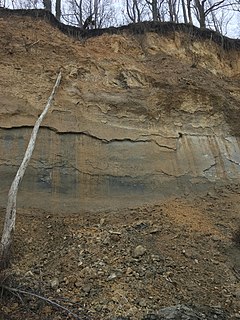Chesapeake Group
Appearance
| Chesapeake Group | |
|---|---|
| Stratigraphic range: Neogene | |
 Calvert Formation Exposed at Brownies Beach | |
| Type | Group |
| Sub-units | Calvert Formation, Choptank Formation, St. Marys Formation, Eastover Formation, Yorktown Formation, and Chowan River Formation |
| Location | |
| Region | |
| Country | |
The Chesapeake Group is a geologic group in Maryland, Virginia, Delaware, and North Carolina.[1][2][3] It preserves mainly marine fossils dating back to the Miocene and Pliocene epochs of the Neogene period.[4] This group contains one of the best studied fossil record of Neogene oceans in the world. Professional Paleontologists and amateur fossil hunters alike collect from this group intensely. The Calvert Cliffs stretch the length of Calvert County, Maryland and provide the best continuous stretch of the Calvert, Choptank, and St. Marys Formations.
See also
- List of fossiliferous stratigraphic units in North Carolina
- List of fossiliferous stratigraphic units in Maryland
- List of fossiliferous stratigraphic units in Delaware
- List of fossiliferous stratigraphic units in Virginia
References
- ^ "Calvert Cliffs Fossils". mgs.md.gov. 2014. Retrieved 24 June 2014.
- ^ "Chesapeake Group | The Delaware Geological Survey". www.dgs.udel.edu. Retrieved 2020-08-14.
- ^ "(PDF) Miocene bony fishes from the Calvert, Choptank, St. Marys and Eastover Formations, Chesapeake Group, Maryland and Virginia". ResearchGate. Retrieved 2020-08-14.
- ^ "Chesapeake Group | The Delaware Geological Survey". dgs.udel.edu. 2014. Retrieved 24 June 2014.
- Various Contributors to the Paleobiology Database. "Fossilworks: Gateway to the Paleobiology Database". Archived from the original on 31 July 2014. Retrieved 22 June 2014.
{{cite web}}:|author=has generic name (help)
